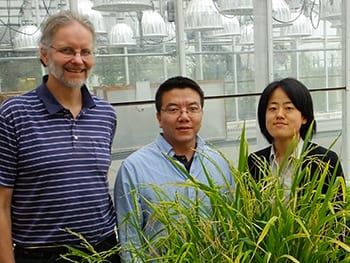News
Why Rice Can’t Get Along with Its Neighbors

Professor Georg Jander, Associate Professor Jian Yan of the South China Botanical Garden at the Chinese Academy of Sciences and Takako Aboshi, now an associate professor at Yamagata University in Japan
Plants can’t pack up and leave when they don’t like their new neighbors, but some plants, including rice, can produce chemical inhibitors that weed out the competition.
Researchers in the Jander laboratory at BTI have discovered a new compound in certain rice varieties that may slow the growth of nearby plants. Associate Professor Jian Yan of the South China Botanical Garden at the Chinese Academy of Sciences and Takako Aboshi, now an associate professor at Yamagata University in Japan worked with collaborators at Kyoto University and Cornell University, to identify the compound, called b-tyrosine. It curtails root growth in other plants in laboratory tests, and may also have antibacterial properties. Their discovery is published in an online article in The Plant Cell.
“Rice is one of the best-studied plants in the world, but still, there are a lot of compounds in there that are novel,” said BTI Professor Georg Jander. “b-tyrosine was completely unknown as a rice metabolite or even as a plant metabolite.”
Jander suspects that rice plants use b-tyrosine for allelopathy—a phenomenon where a plant gives off chemicals into the surrounding soil that stop competing organisms from encroaching on their territory.
Perhaps the best-known example of allelopathy is from the walnut tree. Experienced gardeners know that many plants do not thrive beneath one. Even Pliny the Elder, a Roman philosopher and naturalist, recorded this observation in an AD 79 publication. In 1851, two scientists discovered that a walnut compound called juglone was responsible for stunting the growth of neighboring plants.
Some rice varieties are especially good at suppressing weeds, and other allelopathic compounds from rice have been well studied. Nevertheless, weeds can be a major problem, particularly for upland rice, which is not grown in flooded paddies. Therefore, breeding that increases rice allelopathy may be one way that farmers can deal with this issue.
Researchers in the Jander laboratory first discovered b-tyrosine while looking for new defense compounds in rice. Previously, b-tyrosine was known primarily as a constituent of a type of antibiotics called polyketides. It has the same chemical formula as a-tyrosine, one of the 20 standard amino acids that plants use to make proteins, but with a slightly different arrangement of atoms. Plants use non-protein amino acids like b-tyrosine as defensive compounds because they often have toxic properties and don’t break down easily in the environment.
When Yan tried to classify the compound’s defensive properties, he discovered that b-tyrosine did not deter insects, at least not at concentrations that would normally be found in the plant. Aphids, black cutworm larvae and sugarcane borer larvae all survived on diets spiked with b-tyrosine. But when they tried to grow a type of bacteria that commonly infects crops, called Pseudomonas syringae, they found that even low concentrations of the compound could reduce bacterial growth. Rice plants make b-tyrosine in the leaves, where it may help prevent bacterial infections.
Perhaps most striking, b-tyrosine could reduce root growth in multiple different plant species. Rice varieties that generate b-tyrosine, as well as other grasses, were immune to its effects, but the compound was especially effective against dicots—flowering plants that have two embryonic leaves when they sprout, including lettuce, tomatoes and oak trees.
The researchers used genetic mapping to show that b-tyrosine biosynthesis is encoded on rice chromosome 12, where they discovered the responsible gene, called TAM1. It encodes tyrosine aminomutase, an enzyme that converts a-tyrosine into b-tyrosine.
But not all rice varieties are made equal. Researchers found b-tyrosine in a majority of the japonica, or short-grain, varieties that they tested, but the compound was absent in long grain indica and aromatic varieties. Humans domesticated rice twice, and the researchers found that one ancestral rice species had TAM1 and passed it on to its descendants, while the other didn’t.
In future experiments, the researchers plan to test the ability of b-tyrosine-producing rice to inhibit growth of its neighbors. They’ll compare Nipponbare, a variety with TAM1, to the same variety but with a mutation that blocks b-tyrosine production, to see how well the compound inhibits the growth of nearby plants in soil. The researchers know that rice excretes b-tyrosine, but they don’t yet know if it accumulates in the soil at concentrations that will deter weeds.
“What we need to consider is, are these physiologically-relevant concentrations? We think we’re in the range where we might be doing damage to other plants,” said Jander. However, they believe that b-tyrosine is “one piece of the puzzle of what makes rice able to inhibit the growth of other kinds of plants.”


